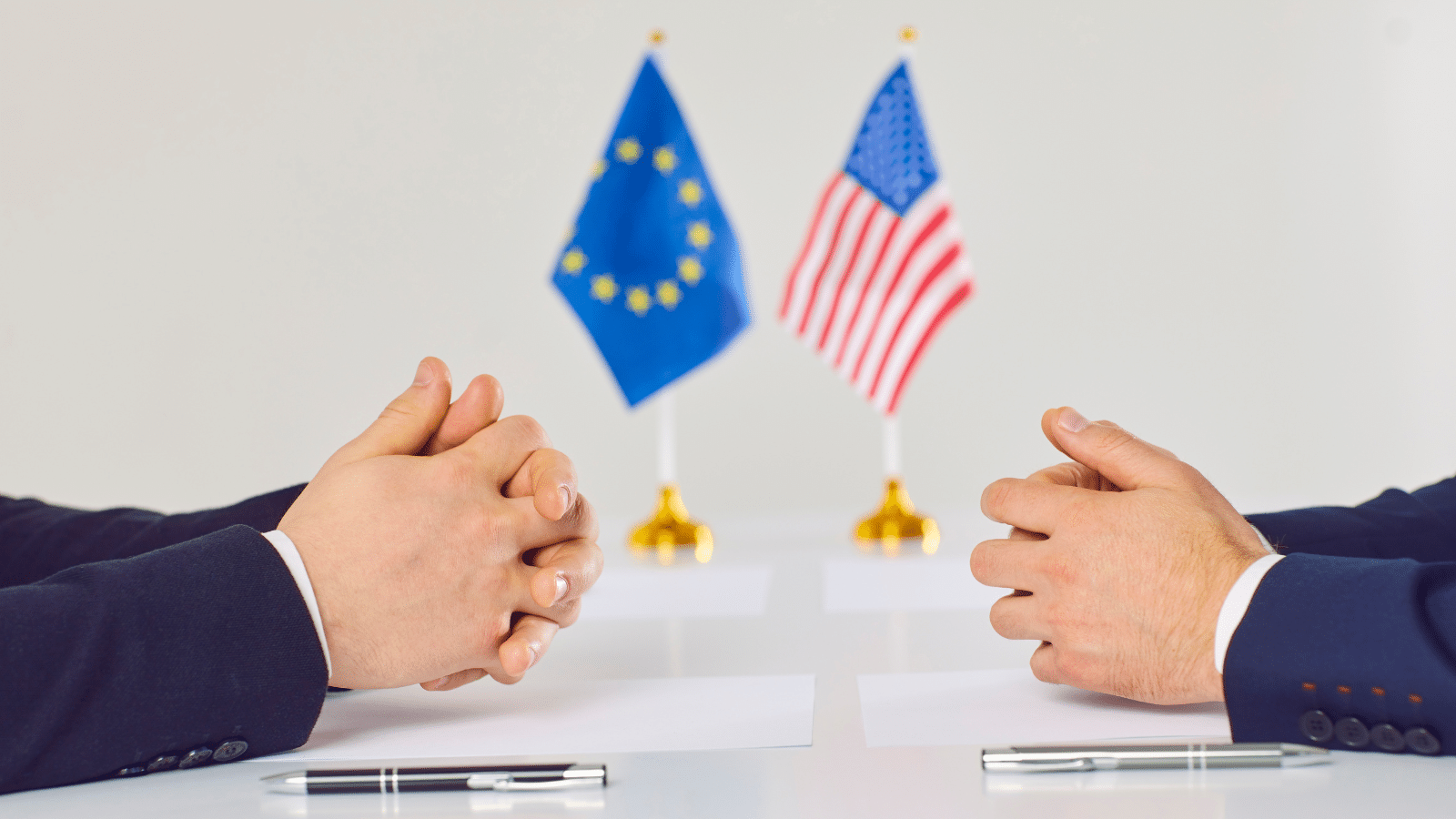This Energy Explained post represents the research and views of the author. It does not necessarily represent the views of the Center on Global Energy Policy. The piece may be subject to further revision. Contributions to SIPA for the benefit of CGEP are general use gifts, which gives the Center discretion in how it allocates these funds. Rare cases of sponsored projects are clearly indicated.
For a full list of financial supporters of the Center on Global Energy Policy at Columbia University SIPA, please visit our website at Our Partners. See below a list of members that are currently in CGEP’s Visionary Circle. This list is updated periodically.
2024 is the “ultimate election year,” with more voters than ever heading to the polls in a record 64 countries representing half of the global population.[1] This includes elections in the United States and the European Union, which will influence the trajectory of transatlantic cooperation on climate and trade policies, most imminently regarding tariffs on emission-intensive products.
For over a year, the Biden administration has attempted to forge a deal with the EU to replace the Trump-era Section 232 tariffs on steel and aluminum with a cooperative, multilateral arrangement to promote their sustainable low-carbon production.[2] But an announcement from President Biden late last month quietly signaled the likely end of US-EU negotiations at least until after the upcoming elections.[3]
While any new negotiations are unlikely to begin in earnest until early 2025, this is an important year to take stock and identify the key sources of friction and options to alleviate them. In this Q&A, the authors explain the challenges around these negotiations and show how policymakers can prepare now to make progress when the next opportunity arises—by offering a potential path forward to bridge climate and trade policy divides on emission-intensive products, starting with steel and aluminum.
Why is it challenging for the US and the EU to reach an agreement on carbon tariffs?
The friction between the allies stems from their different approaches to climate policy. The centerpiece of the EU’s climate strategy is a cap-and-trade emissions trading system (ETS) and the carbon border adjustment mechanism (CBAM)—currently in a transitional phase—that will effectively apply the ETS carbon price to imports.[4] While the CBAM is controversial, the EU views it as essential to avoid “carbon leakage,” wherein foreign producers that don’t have to pay the stringent carbon price gain a competitive advantage and emissions are effectively transferred to another region.[5]
In contrast, the United States’ Inflation Reduction Act (IRA), in conjunction with the Infrastructure Investment and Jobs Act (IIJA) and other measures, reflects a subsidy-focused strategy for achieving the country’s climate goals. Consistent with this strategy, the Biden administration proposed the Global Agreement on Sustainable Steel and Aluminum (GASSA), effectively a “climate club” of nations committed to producing low-carbon industrial products with the objectives of avoiding their overproduction and applying punishing tariffs on dirtier imports from nonmembers.[6] The vision for GASSA is that members of the club would impose common tariffs, based on the emissions embedded in carbon-intensive imports, that would supersede both the CBAM and the Trump-era steel and aluminum tariffs. The proposed arrangement reflects the reality that the US cannot employ a carbon-based tariff system like the EU CBAM because opponents in Congress have prevented a national carbon price from being implemented.[7]
What is the current state of play?
After more than a year of contentious negotiations between EU and US officials over the tariffs—compounded by IRA provisions that favor American producers—the Biden administration announced at the end of last year that it would extend partial tariff exemptions on EU-produced steel and aluminum for another two years, signaling a temporary hold on the negotiations.[8] This action appears to relinquish a key bargaining chip for the United States (the threat of reinstating the tariffs) past the current electoral cycle.
With the 2024 elections looming, the pause in negotiations is understandable. Neither side wants to risk reaching a difficult and likely unpopular compromise—due to the added complexities and costs for firms on both sides—only to see it unravel with a change in political winds. Effectively, the can has been kicked to next year. If President Biden wins his reelection bid and the EU climate action resolve is not weakened following the parliamentary election—neither is a given at this point—negotiations will likely resume under a tight time constraint. Both the CBAM and the full Section 232 tariffs kick in at the beginning of 2026, leaving only a year to find a compromise. If, instead, a Republican is elected president, not only would a transatlantic agreement on sustainable steel and aluminum production be unlikely but, more broadly, current federal climate efforts could face substantial challenges, potentially stalling or rolling back.[9]
Why is it critical to reach a deal?
Reaching a deal is imperative not only to avoid a transatlantic trade war but also to prevent backtracking of climate policies in the US and the EU that could reverberate globally.[10] While so far the negotiations have focused on just two sectors—steel and aluminum—forging a transatlantic climate club could be the foundation for multilateral cooperation across a broader swath of internationally traded, carbon-intensive products. Failure to cooperate could instead accelerate a global fragmentation of clean energy markets, with China left to continue dominating the supply chains of these markets.
What are the key obstacles to forming a climate club?
While US and EU leaders share the policy priorities of revitalizing their respective industrial bases and encouraging lower carbon production of industrial products, their vastly different approaches—largely reflecting differing political constraints and historical policy evolution—are difficult to reconcile within the framework of a climate club.[11]
First, the EU approach focuses on climate policy, with tariffs based on a market-determined carbon price from its ETS. In contrast, the US GASSA proposal appears more focused on addressing issues like excess capacity, arising from the non-market practices of competitors like China, than decarbonizing steel and aluminum industries. Moreover, as previously mentioned, the lack of a national carbon price in the US means the tariff would not be linked to domestic climate regulations. Second, in computing the tariffs, the US proposal considers industry-wide emission intensity averages, while the EU CBAM is applied at a facility level—thus lowering emissions by making high-emitting companies either pay more in tariffs or take steps to decarbonize.
Is there a feasible path forward?
A narrow path forward, albeit one that sidesteps European concerns about the IRA subsidies, has been proposed by the authors in the form of a climate club with very specific rules, initially only for steel and aluminum and open to countries with comparably low industry-wide emission intensities.[12] The key elements of this approach are described below.
First, instead of the GASSA’s common tariff, the climate club would allow members to devise their own unique tariff methodologies and accompanying domestic regulations. This would be consistent with the EU’s CBAM, which has already compelled other countries to reexamine their carbon pricing mechanisms (or lack thereof). This may be preferable even from the US standpoint, as a fixed formula-based tariff would mean losing an important foreign policy tool; for example, the 200 percent tariff the US imposed on Russian aluminum exports last year would be inconsistent with GASSA.[13] Moreover, a flexible arrangement that does not require a domestic carbon price is more likely to be politically viable in the US Congress, where there is bipartisan concern about the unfair trade practices of competitors like China.[14] Overall, giving policy flexibility to members would make the suggested climate club a workable compromise, similar to the Paris Agreement, which succeeded while previous efforts failed, and is based on countries’ own “bottom-up” climate commitments instead of centralized “top-down” mandates.[15]
Second, the climate club would require that the industry-wide emission intensity for a member country remain within a predefined band with a downward trajectory over time. It will be difficult for the United States to make such a binding commitment, but a Senate-approved multilateral agreement that appears to benefit US producers—like the Kigali Amendment to phase out hydrofluorocarbons in 2022—could be feasible.[16] Not only would this be consistent with net-zero targets of member nations, but it would also address the discrepancy between CBAM (applied at a facility level) and GASSA (emissions measured at an industry level). While facilities with high carbon emissions may initially be shielded by industry-wide measurements in the US and other member countries, in due course, countries would need to deal with their high-emitting outlier facilities in order to remain members of the climate club. Moreover, this approach would also avoid the thorny issue of “resource shuffling”—i.e., exporting cleaner products relative to those consumed domestically—that CBAM glosses over.[17]
Finally, to mitigate some of the concerns of emerging market and developing economies, the tariff revenues collected by the club would entirely be directed to support decarbonization efforts in these countries.[18] Neither CBAM nor GASSA proposes a similar step.
The elections this year will likely have profound implications for global peace and human rights, but it is also important not to lose sight of looming issues at the intersection of climate and trade that may very well decide the trajectory of progress in dealing with the climate crisis.
CGEP’s Visionary Circle
Corporate Partnerships
Occidental Petroleum Corporation
Tellurian Inc
Foundations and Individual Donors
Anonymous
Anonymous
the bedari collective
Jay Bernstein
Breakthrough Energy LLC
Children’s Investment Fund Foundation (CIFF)
Arjun Murti
Ray Rothrock
Kimberly and Scott Sheffield
Notes
[1] Koh Ewe, “The Ultimate Election Year: All the Elections Around the World in 2024,” Time, December 28, 2023, https://time.com/6550920/world-elections-2024/.
[2] Kim Mackrael, “U.S. and Europe Struggle to Put Trump-Era Tariffs Behind Them,” Wall Street Journal, October 20, 2023, https://www.wsj.com/economy/trade/u-s-and-europe-struggle-to-put-trump-era-tariffs-behind-them-e8efead3.
[3] “Biden Extends EU Steel, Aluminum Tariff Exemption for 2 Years,” Reuters, December 28, 2023, https://www.reuters.com/world/us/biden-extends-eu-steel-aluminum-tariff-exemption-2-years-2023-12-28/.
[4] European Commission, “Carbon Border Adjustment Mechanism,” Taxation and Customs Union, 2023, https://taxation-customs.ec.europa.eu/carbon-border-adjustment-mechanism_en.
[5] Joel Trachtman and Jan Yves Remy, “Comment: The EU’s Carbon Border Tax is a Blow to Climate Justice. Here’s How to Fix It,” Reuters, November 15, 2023, https://www.reuters.com/sustainability/boards-policy-regulation/comment-eus-carbon-border-tax-is-blow-climate-justice-heres-how-fix-it-2023-11-15/.
[6] Ana Swanson, “U.S. Proposes Green Steel Club That Would Levy Tariffs On Outliers,” New York Times, December 7, 2022, https://www.nytimes.com/2022/12/07/business/economy/steel-tariffs-climate-change.html.
[7] Bill Cassidy Senate Office, “Cassidy Leads Republican Senate Opposition to a Carbon Tax,” press release, October 26, 2023, https://www.cassidy.senate.gov/newsroom/press-releases/cassidy-leads-republican-senate-opposition-to-a-carbon-tax/.
[8] Andy Bounds, “EU Rejects US Offer to End Steel Tariff Dispute,” Financial Times, June 28, 2023, https://www.ft.com/content/42d968e5-cb13-4ccb-9f93-b1a321303a14.
[9] Adam Aton, “’Trump Insurance’: How States Could Fortify Climate Policy in 2024,” ClimateWire, December 22, 2023, https://subscriber.politicopro.com/article/eenews/2023/12/22/trump-insurance-why-2024-could-see-states-entrench-climate-policy-00132960.
[10] Noah Kaufman, Chris Bataille, Gautam Jain, and Sagatom Saha, “As US-EU Trade Tensions Rise, Conflicting Carbon Tariffs Could Undermine Climate Efforts,” The Conversation, January 23, 2023, https://theconversation.com/as-us-eu-trade-tensions-rise-conflicting-carbon-tariffs-could-undermine-climate-efforts-198072.
[11] Inu Manak and Helena Kopans-Johnson, “In Green Steel Discussions, the United States Is Playing Dirty,” Council on Foreign Relations, November 8, 2023, https://www.cfr.org/blog/green-steel-discussions-united-states-playing-dirty.
[12] Sagatom Saha, Noah Kaufman, Gautam Jain, and Christopher Bataille, “Green Gridlock: How to Fix the U.S.-EU Disconnect on Climate,” Foreign Affairs, April 25, 2023, https://www.foreignaffairs.com/united-states/green-gridlock.
[13] “U.S. to Impose 200% Tariff on Aluminum from Russia—White House,” Reuters, February 24, 2023, https://www.reuters.com/markets/commodities/us-impose-200-tariff-aluminum-russia-white-house-2023-02-24/.
[14] The Select Committee on the CCP, “Select Committee Adopts Proposal to Reset Economic Relationship with The People’s Republic of China,” press release, December 12, 2023, https://selectcommitteeontheccp.house.gov/media/press-releases/select-committee-adopts-proposal-reset-economic-relationship-peoples-republic.
[15] David G. Victor, “Why Paris Worked: A Different Approach to Climate Diplomacy,” Yale Environment 360, December 15, 2015, https://e360.yale.edu/features/why_paris_worked_a_different_approach_to_climate_diplomacy.
[16] US Department of State, “U.S. Ratification of the Kigali Amendment,” September 21, 2022, https://www.state.gov/u-s-ratification-of-the-kigali-amendment/.
[17] Eklavya Gupte, “Bureaucratic, Political Hurdles in Store as EU’s Carbon Tax Enters Force,” S&P Global, October 2, 2023, https://www.spglobal.com/commodityinsights/en/market-insights/latest-news/energy-transition/100223-bureaucratic-political-hurdles-in-store-as-eus-carbon-tax-enters-force.
[18] The London School of Economics and Political Science, “Africa Could Lose Up to $25 Billion Per Annum as a Direct Result of the EU’s CBAM,” May 9, 2023, https://www.lse.ac.uk/News/Latest-news-from-LSE/2023/e-May-2023/Africa-could-lose-up-to-25-billion-per-annum-as-a-direct-result-of-the-EUs-CBAM.









